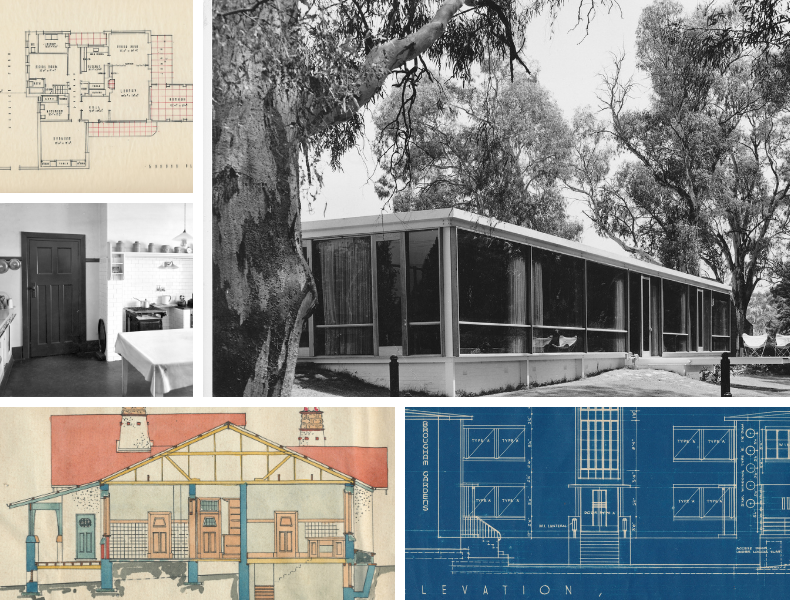Exhibition: Modern Living: At home in South Australia, 1890 - 1960
Monday to Friday, 9am-5pm and Thursdays until 6pm (closed on public holidays)
Monday to Friday, 9am-5pm and Thursdays until 6pm (closed on public holidays)

Gallery open Monday - Friday 9am - 5pm (Thursdays until 6pm)
Hawke Building Level 3, UniSA City West campus, 55 North Terrace, Adelaide MAP
Presented by The Bob Hawke Prime Ministerial Centre and Architecture Museum, University of South Australia, as part of South Australia's History Festival and Open Doors
From efficient kitchens and hygienic surfaces to internal plumbing and sun shading, the modernisation of the home has a long history. This exhibition examines some of these influences with a focus on houses designed for South Australia, ranging from the model cottages of the late Victorian era to architect-designed Modernist houses. Architectural drawings, photographs, books, posters and pamphlets were all used to communicate with the public on aspects of modern living during this period, and this exhibition uses such items from the collections of the Architecture Museum to uncover the ways in which the homes we inhabit shape our domestic lives.
The residences featured in the exhibition demonstrate modern ideas in architecture with regards to efficient and functional home planning, the use of new materials, trends in decoration and ornamentation, and the provision of open and light spaces. Many improvements in living conditions in the modern house were achieved through architectural means including improved plumbing and sewerage, ventilation systems, a preference for hygienic materials and surfaces, efficient room layouts - especially in kitchens, bathrooms and laundries, and the design of outdoor areas. These innovations reflect the widespread modern preoccupations with cleanliness, health, sunlight, fresh air, scientific management, open and functional planning - all of which characterised modern architectural thinking of the twentieth century.
Curated by Dr Julie Collins from the Architecture Museum, University of South Australia.
The Architecture Museum is a research collection of architectural design documentation, drawings, photographs, artefacts and ephemera. As a facility for the acquisition and preservation of South Australian architectural records, its holdings currently comprise over 200,000 items. The Architecture Museum promotes intellectual enquiry into the state’s built environment history and supports research undertaken by staff, students and external researchers. The Architecture Museum is open to the public and is located in the Kaurna Building at the City West Campus of the University of South Australia.
![]()

Images: All images from the collections of the Architecture Museum, University of South Australia.
HERO IMAGE, CLOCKWISE: Badger House, Unley Park, 1957. Langdon Badger, Designer, with Keith Neighbour, Architect of Lawson, Cheesman, Doley and Partners. Jack Cheesman collection, S361/25; Deepacres Apartments, North Adelaide, Jack McConnell Architect, 1942. Drawing, Hurren, Langman and James collection, S247/92; Section through residence at Clare, F.Kenneth Milne Architect, 1912. F. Kenneth Milne collection, S5/15/1; Kitchen at Thorngate, South Australia, F. Kenneth Milne Architect, c.1917. Milne collection, S3/4/4; Plan for residence at Netherby, South Australia, [1938]. Russell Ellis Architect, Ellis collection, S89/24/2.
While the views presented by speakers within The Bob Hawke Prime Ministerial Centre public program are their own and are not necessarily those of either the University of South Australia or The Bob Hawke Prime Ministerial Centre, they are presented in the interest of open debate and discussion in the community and reflect our themes of: Strengthening our Democracy - Valuing our Diversity - and Building our Future. The Hawke Centre reserves the right to change their program at any time without notice.
The copying and reproduction of any transcripts within the Hawke Centre public program is strictly forbidden without prior arrangements.
While the views presented by speakers within The Bob Hawke Prime Ministerial Centre public program are their own and are not necessarily those of either the University of South Australia, or The Bob Hawke Prime Ministerial Centre, they are presented in the interest of open debate and discussion in the community and reflect our themes of: Strengthening our Democracy - Valuing our Diversity - Building our Future. The Hawke Centre reserves the right to change their program at any time without notice.